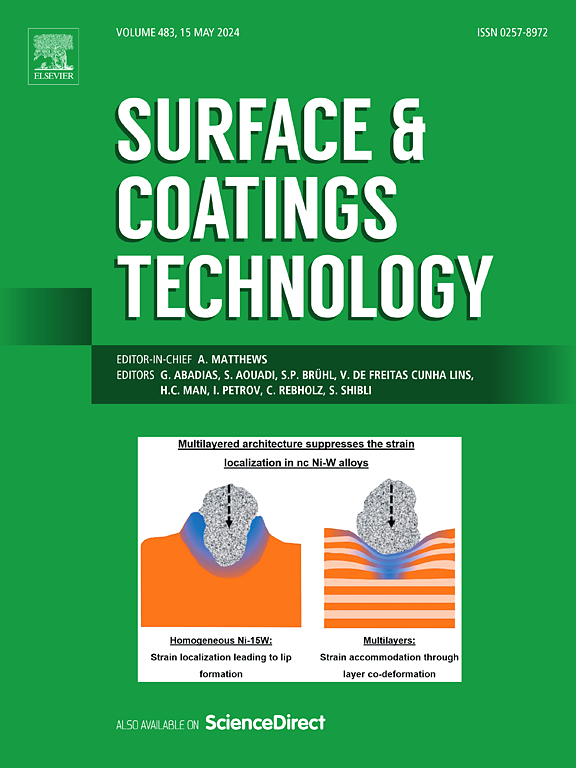研究了爆轰喷涂Cu-Cr复合涂层的显微组织及其在电弧侵蚀条件下的性能
IF 5.3
2区 材料科学
Q1 MATERIALS SCIENCE, COATINGS & FILMS
引用次数: 0
摘要
Cu-Cr复合材料具有良好的电学和力学性能,广泛应用于真空断路器的电触点。本研究采用爆轰喷涂技术在铜基体上形成Cu-Cr复合涂层。采用含铬量为25%至67%的粉末混合物进行喷涂工艺,并制备纯铜涂层作为参比材料。采用光学显微镜(OM)、扫描电镜(SEM)、透射电镜(TEM)、能量色散x射线能谱(EDX)和x射线衍射(XRD)分析表征了涂层的微观结构和组成。通过电弧侵蚀测试评估涂层的性能,并通过光学轮廓术分析测试后样品的表面形貌。TEM分析表明,纯铜涂层中存在纳米级的铜氧化物,Cu-Cr涂层中存在纳米级的铬氧化物。爆轰喷涂Cu-Cr涂层具有高硬度(240±10 HV)、高粘接强度(45±10 MPa)、低孔隙率(<;1%)。根据铬含量的不同,镀层的电导率在25% ~ 41% IACS之间变化。值得注意的是,铬含量为33-43 wt%的涂层在电弧照射后没有表面突出,表明具有更好的抗电弧损伤能力。本文章由计算机程序翻译,如有差异,请以英文原文为准。

The microstructure of Cu-Cr composite coatings produced by detonation spraying and their behavior under arc erosion conditions
Cu-Cr composites are extensively used as electrical contacts in vacuum circuit breakers due to their favorable electrical and mechanical properties. In this study, Cu-Cr composite coatings were formed on copper substrates by detonation spraying. Powder mixtures with chromium content ranging from 25 to 67 wt% were employed for the spraying process, and a pure copper coating was also prepared as a reference material. The microstructure and composition of the coatings were characterized using optical microscopy (OM), scanning electron microscopy (SEM), transmission electron microscopy (TEM), energy-dispersive X-ray spectroscopy (EDX), and X-ray diffraction (XRD) analysis. The performance of the coatings was assessed through arc erosion testing, and the post-test surface topography of the samples was analyzed via optical profilometry. TEM analysis revealed the presence of nanoscale copper oxides in the pure copper coatings and chromium oxides in the Cu-Cr coatings, respectively. The detonation-sprayed Cu-Cr coatings exhibited high hardness (240 ± 10 HV) and adhesive strength (45 ± 10 MPa), coupled with low porosity (< 1 %). The electrical conductivity of the coatings varied between 25 and 41 % IACS, depending on the chromium content. Notably, coatings with a chromium content of 33–43 wt% exhibited no surface protrusions after arc exposure, indicating superior resistance to arc-induced damage.
求助全文
通过发布文献求助,成功后即可免费获取论文全文。
去求助
来源期刊

Surface & Coatings Technology
工程技术-材料科学:膜
CiteScore
10.00
自引率
11.10%
发文量
921
审稿时长
19 days
期刊介绍:
Surface and Coatings Technology is an international archival journal publishing scientific papers on significant developments in surface and interface engineering to modify and improve the surface properties of materials for protection in demanding contact conditions or aggressive environments, or for enhanced functional performance. Contributions range from original scientific articles concerned with fundamental and applied aspects of research or direct applications of metallic, inorganic, organic and composite coatings, to invited reviews of current technology in specific areas. Papers submitted to this journal are expected to be in line with the following aspects in processes, and properties/performance:
A. Processes: Physical and chemical vapour deposition techniques, thermal and plasma spraying, surface modification by directed energy techniques such as ion, electron and laser beams, thermo-chemical treatment, wet chemical and electrochemical processes such as plating, sol-gel coating, anodization, plasma electrolytic oxidation, etc., but excluding painting.
B. Properties/performance: friction performance, wear resistance (e.g., abrasion, erosion, fretting, etc), corrosion and oxidation resistance, thermal protection, diffusion resistance, hydrophilicity/hydrophobicity, and properties relevant to smart materials behaviour and enhanced multifunctional performance for environmental, energy and medical applications, but excluding device aspects.
 求助内容:
求助内容: 应助结果提醒方式:
应助结果提醒方式:


